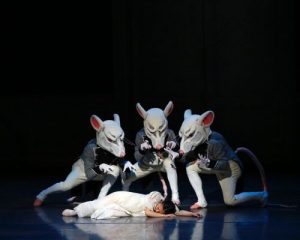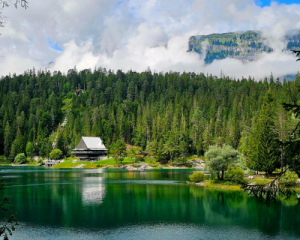
Escape to the enchanted garden of mystical fairies with your children by creating one in your own backyard, or visit one together at this obscure gem of a trail in Mission Viejo.
What child can resist the book, “The Secret Garden”? It’s always been an enchanting notion: A special, hidden space for children, which they transform into their own world with its own stories. A place where adults don’t arrange and guide.
The book has special resonance these days. Through outdoor activity and in-person friendships, two children with dark pasts who have spent too much time brooding indoors become healthy emotionally and physically. That’s quite a message for a society in which children spend far too much time hunched inside with electronic devices.
And through the secret of the garden, they are allowed to have rich inner lives of their own invention, something that children tend to lack in a society where activities are generally organized and overseen by adults.
Not many of us own estates where we can wall off a separate garden for our children. Given the size of most housing lots in Orange County, Mary Lennox’s secret hideaway was probably bigger than most of our front and back yards combined. Fortunately, though, we can shrink the concept of a hidden garden of imagination down to a manageable size and price. They’re called fairy gardens and, small as they are, they’re having a big moment. Even if all you have space-wise is a tiny patio or a corner in a bedroom, that’s enough for a wide, shallow pot that can house a miniature imaginarium where fairies live out their stories, as told and directed by your children.
The languid days of summer are the perfect time for children to start a fairy garden. The backyard is warm and inviting, and they have more free time than usual. In fact, they might be a little bit bored; a fairy garden is a long-term project that not only evolves over time, but also becomes a center for imaginative play.

You could spend a small fortune online finding tiny houses, fairy dolls and other accessories for your child’s fairy garden. But that would take half the joy out of creating one. In fact, the key word here is “create.” With your help and with some very simple materials, children can build their own houses out of sticks, small pieces of driftwood, sand, shells, beach glass and/or little stones, along with some paint and glue. They could add plastic beads if they have them. Some fairy houses consist of nothing more than a faux door glued to the bottom of a tree trunk, with beads or pebbles forming a walkway. But even the complete ones are easy to build, and they don’t need to look perfect. In fact, they shouldn’t look perfect. The idea is rustic and a little ragged, like fairies; one tradition is that only natural materials should be used, but let your children set their own rules. There might be some low-growing succulents or other plants that they could plant in their gardens.
If your child wants the garden to be inhabited, you can certainly look for some of the little resin animals and fairy figurines; many are charming, and you can give one at a time over a year as rewards for good behavior or as little gifts on special occasions. But some children use what they’ve already got, such as little plastic animals from their play sets; or they can make fairies, with your help, out of twigs, clay and fabric.
Before doing any of this, one way to inspire your children about fairy gardens is with a family nature walk to a park full of the miniature gardens. A local enthusiast, Andreas Frank, created the fairyland this past spring along a section of the Oso Creek Trail in Mission Viejo, with the city’s permission and the help of volunteers.
To get there, drive to the corner of La Paz Road and Marguerite Parkway; go just a little bit farther east on La Paz until you see a traffic light with a sign saying Potocki Center for the Arts. Turn left here and find a space in the parking lot.
The fairy-garden area starts as soon as you begin on the trail at the far end of the parking lot. If you keep left onto the dirt path in the grassy area, you’ll find more of the gardens than along the paved path, though they’re in both areas. Most of the fairy gardens are only a few inches high and constructed against the bottoms of trees, fence posts and rocks. They range from simple doors with pathways to little stone houses and a couple of more elaborate creations including a tower. A fairy map is available in the arts center. The trail is also family friendly, with a butterfly garden and maze, and dogs on leash are allowed.
The arts center has been giving workshops on how to build a fairy garden and fairy home, for $35 plus a $10 materials fee. Four classes will be held in July and August; for more information, visit thecaringfairies.com/1.html or call 949-470-8470.
If your children are old enough, you might want to read a chapter of “A Secret Garden” to them each evening at bedtime.
The key, though, is to let your children own this experience as much as possible. They’ll need your help with some raw materials and perhaps with building a tiny house or wishing well but encourage them to do as much of it themselves as possible. There’s always the opportunity to replace items, or add to the garden. Give them a hidden little corner of your yard if you have one, perhaps where there’s a tree or some large rocks, so that it will feel cozy and private. And secret.
 Karin Klein is a 34-year Orange County resident, a freelance writer and editor, and the author of the hiking guide “50 Hikes in Orange County.” She is a naturalist for both OC Parks and the county chapter of the American Cetacean Society.
Karin Klein is a 34-year Orange County resident, a freelance writer and editor, and the author of the hiking guide “50 Hikes in Orange County.” She is a naturalist for both OC Parks and the county chapter of the American Cetacean Society.









Leave a Reply